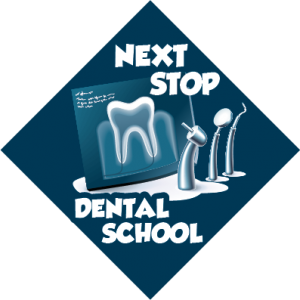Good morning! Today is the most important day for every pre-dental student planning on attending dental school for the 2014-2015 school year! The 2014 AADSAS application season has begun! By now you should have most of the application completed; if not, don’t hesitate to make an account and start filling out the application as you collect all the required information for the application! There is still plenty of time to turn everything in so don’t panic just yet!
Keep in mind that dental school admissions are based on a rolling admissions system, in which fewer people are admitted as time passes. In essence, it is easier to get into dental schools if you apply right away rather than a few months in.
Here are a few question compiled from our FAQ section:
How do I make a DENTPIN?
A DENTPIN is needed in order to apply and take the DAT as well as opening an AADSAS application. Most of you should have a DENTPIN from taking the DAT; however, for those taking the DAT after submitting their AADSAS please visit the DENTPIN registration page now and pay for the DAT soon! There is a bit of processing time involved.
I forgot my DENTPIN. What should I do?
If you forgot your DENTPIN search your email inbox for the subject “DENTPIN Registration Successful” or click one of the links below to resend the information:
How do I make a Portal account?
When the application opens at 12:00 PM EST on June 3, 2013, the option to “Create New Account” will be activated and can be found immediately under the login on the left hand side. This is when you’ll be able to create a username and password. Make sure you have your DENTPIN handy, you’ll need it to create an AADSAS application account!
I keep hearing apply early. What does “early” mean when it comes to submitting my application?
Generally, if you apply before the end of the month of July, you are considered an early applicant. Applications within the first month are immediately processed but not reviewed by dental schools for roughly another month (It varies for each dental school). As a result, submitting on the first day does not have a significant advantage over submitting than the end of June. However, the rule of thumb is that if you have all the sections ready, then you should submit it as soon as the application is available.
There isn’t a distinct cut-off for what is defined as an early applicant. Think of it as a gradient throughout the cycle. The later it is in the cycle one submits, the less early an applicant is.
When should I take my DAT if I have not done it yet?
It is highly recommended that the DAT is completed as early as possible. Having a DAT score is not a requirement to submit the application. You can indicate that you plan to take it in the near future. To still be considered a moderately-early applicant, you should have your DAT done no later than the end of July. You can take your exam later than that, but your application will lose its early advantage it had when you initially submitted it. Applications missing sections are put on hold until the section missing is received. I have heard of people taking the DAT as late as October or November of their application cycle!
What is a good DAT score?
You should aim for as high as possible, however a nice“safe” score is 20 and above. This applies to virtually all dental schools. Rule of thumb is that if you score 17 or under on any section, then you should retake the test. Anything that low is not considered a competitive score and is immediately rejected at many dental schools.
Should I Retake the DAT?
You can take the DAT once every 90 days and are only allowed 3 attempts. Your last attempt is the score that is reviewed by dental schools. Please be aware that any regression in score will override any higher scores previously earned. Only take the test if you are ready to take it again, do not do it just because you can! If you are taking the DAT while applying, make sure you give yourself adequate time to prepare. Extending your test date by a week will be more beneficial than waiting 3 months in order to retake it.
How long does it take for dental schools to receive my application?
Your application’s delivery time can vary significantly. Some schools fall under a 3-6 week window while other schools fall under a 6-8 week window. Since the delivery window can vary over a month, it is best to have the mindset that all of your desired dental schools will receive your application no later than 3 weeks after applications open June 4th. This way, you give yourself a specific goal that will prevent your applications completion from dragging on weeks or months longer than it should!
During this time period, your transcripts will be compared to the grades entered on the AADSAS application. This can take a significant amount of time especially during the peak of the application season.
Side note: Applications seem to be sent to schools in batches made up by a few weeks of applications. This batch delivery system is frequently talked about by applicants and seems to be based on similar status changes occurring at the same time on the AADSAS website.
Can I submit my official transcripts before the AADSAS application opens?
No, official transcripts will not be accepted unless they are sent along with the AADSAS “Transcript Matching Form”. Once the AADSAS application is submitted, you will be provided with a form to deliver to all the schools you have attended. The form includes a barcode that allows AADSAS to locate and verify your application.
Can I submit my Letters of Recommendation/Evaluation before the AADSAS application opens?
No, Letters of Recommendation and Letters of Evaluation will not be accepted unless they are sent along with the AADSAS “Letter of Evaluation Matching Form”. Once the AADSAS application is submitted, you will be provided with the form to give to all recommenders or to interfolio or similar services offered by most colleges. The form includes a barcode that allows AADSAS to locate and verify your application.
What should I do while I am waiting for dental schools to receive my application?
After submitting your application through AADSAS, check all the websites of the dental schools you are applying to to learn more about their secondary application. Many schools view a secondary application as a REQUIRED supplemental application in order for an application to be viewed. Other schools may send a secondary application after an applicant meets their initial requirements like GPA and DAT scores. You can find basic information (e.g. cost of application and if the application is invite only vs. public) about any dental school’s supplemental application on the ADEA Supplemental Information webpage. Begin filling out any secondary applications that are available. You can find information about supplemental applications before they are released on resources like StudentDoctor.net or from your pre-dental/dental student colleages.
Where can I find supplemental applications for the dental schools I am applying to?
Many schools have a supplemental or secondary application which is a requirement to begin viewing an application. Other schools may send a secondary application after meeting initial requirements like GPA and DAT scores. You can find basic information (e.g. cost of application and if the application is invite only vs. public) about any dental school’s supplemental application on the ADEA Supplemental Information webpage. Begin filling out any secondary applications as soon as they become available.
Supplemental applications that are available openly to all applicants can be found through the dental school’s website. These supplemental applications usually open up around the same time as the AADSAS application. To find out more information about a particular school’s supplemental application, go to the prospecting students section of the website or search the phrase “[dental school name] dental supplemental/secondary application” using a search engine like google. You can also add “Student Doctor Network” to the end of the search phase to read discussions about the secondary/supplemental application from fellow dental school applicants.
Please note that some supplemental applications are invitation only which requires the dental school applicant to pass the initial screening of academic performance before being approved to fill it out.
What if I submit my application immediately, but I am waiting for a letter of recommendation?
Every requirement of the application must be ready in order to have the application viewed by dental school admissions. If any part of the application is missing, the whole application is put on hold until the required pieces are submitted. This most commonly happens due to a late letter recommendation. It is highly recommended that you request a letter of recommendation very early on in the process and give the writer a deadline a few weeks prior to the actual June 4th deadline. This gives you a little safety window in the case that the individual may have forgotten to write the recommendation letter.
The key message to this is that you should have EVERYTHING ready to go!
That said, if this is no longer an option, it is alright. If the letter is a physical copy or is a committee letter of some sort that will be mailed to AADSAS, all you need is the contact information of the letter of recommendation writer/service and AADSAS will provide you with a “Letter of Evaluation Matching Form” that must be included with the letter of recommendation. Give this form to the writer and let them know that your application is on hold until their letter is received by the AADSAS system.
I have a few C’s. Will that prevent me from getting into dental school?
1 or 2 C’s will not hinder your application much. Depending on the difficulty of the class, a C can be considered acceptable.
Can I get into dental school with a failing grade (D or F)?
Yes you can! Make sure to retake the course and get a high grade. Unlike most colleges, dental schools will not replace the failing grade. They will request both the failing grade and the repeat grade. Be prepared to explain why you may have failed the course and what you have done to improve. Do not make excuses!!
What factors make up a strong dental school applicant in the eyes of dental school admissions?
Fulfilling all these categories will put you and your application in a very good standing. Being solid in all of these categories will make you an extremely strong applicant anywhere.
- Coursework
- Gives the admissions officers an idea about the difficulty of your classes, types of classes, and diversity of classes.
- Course Load Sufficiency
- Maintaining a dense course load throughout college is very important. This shows dental schools that you can perform strongly in very intense and demanding situations.
- GPA
- A numerical value calculated based on your performance in classes. Several versions of your GPA are evaluated. Mainly a science GPA and total GPA.
- DAT
- Standardized testing score helps balance the inconsistency in GPAs across hundreds of schools.
- Letter of Recommendation
- 2 Science Curriculum letters of recommendation
- 1 Other letter of recommendation
- You can submit more, but some schools may only review 3 out of however many you have.
- It is better to have 3 very strong ones rather than 5 moderately strong letters.
- Personal Statement
- A high quality personal statement can show a lot about you and your personality. This is a great place to show to admissions officers that you are passionate about becoming a dentist.
- Extra-Curricular activities
- Community service is a great way to show admissions that you are doing other things than just studying. Contributions to the community go a long way especially when they know you are busy doing everything else mentioned in this list.
- Leadership
- Having leadership positions in organizations shows your ability to manage others and lead a team. This is vital to becoming a dentist as dentists who own private practices are the boss and are the leaders of a dental team.
- Dental Experience
- It is important to have some shadowing hours. Minimum recommended is 40+ hours; strong candidates have 100+ hours. I would recommend doing as much as you can. Spending as much time in a dental environment as possible will really help you feel confident in your decision to pursue a career in dentistry and give you an idea about the daily nature of the profession.
- My dental experience is the reason why I know dentistry is the career for me. An answer to the question “Why Dentistry” is much stronger when you have experiences that tell your story for you. This is a great way to perfect your personal statement.
- Dexterity
- Proving you have fine motor skills is vital. Pick up a hobby that involves complicated and precise movements. Hobbies like painting, sculpting, or playing an instrument not only show fine motor skills, but they also show admissions officers that you have developed an artistic edge over other dental students.
- My hobby has been soldering and repairing small electronics. To me, it is like performing surgeries. Very precise movements in very tight areas are needed to perform the repairs and built electronics. Research may open up opportunities to perform surgeries on animals for various reasons. I later took on the role of performing catheterization surgeries on rats by implanting a catheter into their jugular vein. Although practicing challenges like these may be difficult to do at first, it is a great way to develop dexterity skills in a stressful environment.
Does applying for a second cycle hurt my chances?
While most schools will see that you have applied previously, they will treat your application similarly to first timers. They may also use another factor to help their decision by looking into how you have bettered yourself since your previous application. This is done by pulling up your previous application and comparing the two to see where developments have been made. If you are applying for a second cycle, be sure to emphasize your improvements during your time off and to spend time making your application look as “fresh” as possible in comparison to your previous application. This includes reworking your personal statement and descriptions, adding more activities, updating with extra classes since the last application, etc.
Does taking a year off between undergraduate and dental school hurt my chances of getting in?
Taking a year off is completely acceptable; in fact, you can take as many years off as you would like! The only catch is that you have to show that you have grown as an individual during that time period. As long as you did not spend the entire year sitting in front of the TV, there should be absolutely nothing to be concerned with when it comes to taking a break from school.
Where can I get status updates for each dental school I applied to?
AADSAS itself has a decent status update system that indicates the current status of your application at every dental school. Please note that it is common for the status to change a few days before or after a milestone occurs (like being accepted or receiving an interview).
You can also join the member driven DDS Applicants resource by Student Doctor Network to get the latest updates from the current pool of applicants. This website will indicate members’ GPA, DAT Scores, the day they submitted their AADSAS application, as well as many other details allowing participants to get a good idea about each dental schools’ stage in the admissions process.
Filling out the AADSAS is fairly straightforward. And if you need any help you can access their guide posted on the AADSAS website. Or our AADSAS application simulator with character limit counters.
Other resources offered by the ADEA:
As always, if you have any questions, please don’t hesitate to ask them through the Ask Elias page. I will prioritize any application questions for the next few months.



